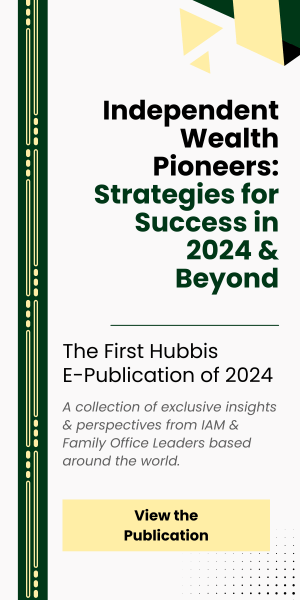Plug-and-Play Banking in a Complex Wealth Ecosystem: The Synpulse OpenWealth One-Stop Solution

Andreas Mettenberger of Synpulse
Nov 6, 2023
In an ever-evolving wealth landscape, banks face the tough but critical decision: to build or buy a wealth platform? In a talk at the Hubbis Digital Wealth Forum in Singapore in early October, Andreas Mettenberger, Associate Partner at Synpulse, set about dissecting the complexities and challenges that banks encounter during this decision-making process. He covered many of the key bases, including integration hurdles, customisation limitations, and scalability concerns. He advised delegates on how the right solutions can help their bank or wealth firm overcome these challenges. Most importantly, he highlighted the new and comprehensive Synpulse platform, namely the PULSE8 OpenWealth Marketplace.
On his route to explaining why plug-and-play banking is so important today, Andreas first offered guests a potted history of the evolution of banking IT environments over the past decades.
Armed with a succinct and easy-to-digest slide show, he explained that in the first 20 years between 1960 - 1980, most of the core banking solutions were built in-house on mainframes, it was not at all scalable, and there was very little system security implemented.
The next two decades were the era of standard software, characterised by centralised, fragmented data management, code and parameter-driven configurability, similarly little security, and slow time-to-market. From 2000 to roughly 2020 was the arrival of the software-as-a-service concept, with key benefits such as asset scalability, API in readiness, and the layering in of FinTech and other solution providers, resulting in an explosion of FinTech and other innovations.
“During that phase, hundreds, actually thousands of solutions were created to choose from, some of them with very niche capabilities or one specific capability as part of the value chain, and others which are looking to achieve more breadth across the value chain,” he explained.
The evolution shifts to a new era
And since 2020, another era has dawned in the form of what Andreas termed ‘Plug and Bank’. With this, core system security has been dramatically improved, data management is fully coordinated and accessible, there is codeless configuration and a very much faster time-to-market.
Andreas then briefly unravelled the emerging and very significant trend towards Plug & Bank, and remarked that 9 out of 10 banks surveyed would like to have APIs to integrate other solutions, and more than half of the banks also require cloud-native architecture and a modular software architecture.
He explained that the top 5 needs identified for core banking systems are: APIs for the integration of solutions; flexibility for the rapid introduction of new products; cloud-native (not terrestrial) architecture; a modular software architecture; and ‘Banking as a Service’ solutions.
Overcoming ever-increasing complexity
“In this environment, people are no longer willing to build everything themselves,” he commented. “They now understand the power of the FinTech ecosystem, and what that can provide to their business in terms of value. Flexibility, agility and speed are vital components.”
“Time to market is key, achieving often a first mover advantage. The modular and Banking-as-a-Service’ protocols allow you to orchestrate all of these individual capabilities in a standardised backend for all the banks.”
Expanding on findings from their Synpulse survey, he reported that there are also five key priorities driving this new approach. These are: stability in operations, a reduction of operational costs, a high level of information security, standard interfaces and openness via open APIs, and high flexibility and modular architecture.
Hitting your targets
“Very simply Plug-and-Play achieves a key set of goals,” he told guests. “They include an increased focus on the core business, reduced complexity, faster time-to-market, an optimised cost structure, more efficient operations, and also improved risk management. He said that outsourcing was a central piece of this puzzle, with the move to wealth-as-a-serivce allowing banks and other institutions to focus on what they are actually in business for and best at – providing advice, products and expertise to their private clients.
However, while all this sounds logical and appealing, it is not easy to select solutions and partners. He showed delegates a map of just the Singapore FinTech ecosystem, comprising hundreds of different names. “Solution and vendor assessment is now a major challenge that banks and wealth managers need to face,” Andreas cautioned. “And of course, you then need to integrate and orchestrate all your chosen individual solutions.”
The Marketplace
And that brought him neatly to a new venture at Synpulse to help solve these issues, in the form of a platform named the PULSE8 OpenWealth Marketplace.
He explained they work with banks, wealth managers, asset managers, and others, as well as solution providers, which might be data providers, FinTech and WealthTech or RegTech providers, and together with those members, they define the standards of the required APIs, and then develop the optimal structures.
“We already have around 60 members signed up for that, working with them on the standardisation roadmap for APIs,” he elucidated. “This should then translate to that vision where you can really go out into that Marketplace, and you just turn on and turn off which capabilities you want and still keep your clear direction and momentum.”
Key advantages all round
For the members (the FinTechs and other innovators) there are clear advantages ahead with all this. There is access to a new distribution channel for products and services and expanding their professional network. They can enable their clients to use the products and services without technical obstacles. Instead of a peer-to-peer integration for each client, they will achieve scalable connectivity. There will be no more cumbersome contract management thanks to the standardised contract framework. And they will have centralised invoicing and debt collection.
For the service consumers, in other words the banks or other wealth management providers, there are also plenty of advantages. They will be using best-of-breed services from the Marketplace to enrich business. They can more easily create new services, features or even intellectual property and increase revenues. Digital self-onboarding will grant very quick access to the Marketplace. There are no more cumbersome contract management issues as those are placed by the standardised contract framework. They can maintain stable and scalable connectivity with service providers and get rid of peer-to-peer integrations.
The wealth continuum
He closed his talk by reconfirming why this is all becoming even more relevant for the wealth management industry. “If you look at the end-to-end wealth continuum, from UHNW to retail, each segment has a different set of needs and expectations. The mass affluent segment will need investment support and perhaps retirement planning help, while the higher the wealth the more complex the needs around legacy planning and so forth.”
That led him to comment that to create a profitable service model across the wealth spectrum, the providers need to connect the different stages in the wealth lifecycle with the right solution. “That is the key to building a successful multi-segment wealth offering,” he concluded.

Associate Partner at Synpulse

More from Andreas Mettenberger, Synpulse
Latest Articles






